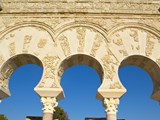Spain’s Cultural Heritage
"Menga is thought to be the only dolmen in continental Europe to have its entrance pointing towards a terrestrial landmark rather than the sun."
Spanish culture and cultural tourism in Spain received a big boost in 2018 when the latest candidate for UNESCO World Heritage status was approved. The Medina Azahara, 5kms to the west of Córdoba and shown in the image on above, raised the number of UNESCO sites in Spain to 46. That’s the third highest number in the world, only Italy and China have more. Andalucía, with a total of 8, has more than any other region in Spain.
In 2016 another example of Spanish culture getting world recognition were the Dolemenes of Antequera. The Dolmenes are a group of three Stone Age burial mounds, between 6,000 and 7,000 years old, individually named as Menga, El Romeral and Viera. Menga is thought to be the only dolmen in continental Europe to have its entrance pointing towards a terrestrial landmark rather than the sun.
Seville: settled by the Romans and known as Hispalis, Seville is Andalucía’s largest city and Spain’s only river port. Columbus’s departure for the New World was from Seville, as was Magellan’s journey which led to the first circumnavigation of the world. It was already an important trading city when it was recaptured from the Arabs in 1248 but flourished even more as the Spanish empire expanded and Seville became one of the world’s richest cities. Three sites have World Heritage status:
The Cathedral, the 3rd largest in the world, housing the tomb of Columbus.
The Alcázar, the oldest royal palace still in use in Europe.
The Archive of the Indies, the repository housing documents recording the Spanish Empire in the Americas and the Philippines. The building is one of Seville’s finest renaissance structures.
Like many Spanish cities, the historic city centre of Seville is flat and compact and there’s no need for a car. Lot’s of people stay away from Seville in the heat of summer but although it is often over 40ºC in July and August it’s a dry heat and Seville is a city that really knows how to live even when it’s at its hottest. Seville claims to be the birth place of tapas, although Granada would disagree, but whoever is right there’s nowhere better for a tapas crawl in the evening, going from bar to bar.
Córdoba
The first traces of human presence date back to the Neaderthals, the first recorded settlements were Carthaginian and the Romans conquered the city in 206 BCE. Under the Arabs it was thought to be the most populous city in the world with as many as 500,000 inhabitants before being reconquered by Ferdinand III in 1236. If you visit in early May you can catch the flower festival in which the patios of Córdoba are open to visitors and the residents compete with each other to produce the most beautiul displays. The courtyards literally drip with flowers.
Granada
After the fall of Córdoba in 1236 Granada was the only seat of Arab rule in Spain, until it too fell in 1492. Three sites have World Heritage status:
The Alhambra, the Generalife and the Albaicín quarter. The Alhambra claims to be Spain’s most visited building, with more than 2.3m visitors each year and it is best to plan ahead. Everything you need to know is on this multi-lingual site.
The summer months are hot but not as extreme as Seville or Córdoba. However, it’s very different at other times of the year given the altitude, 750m or 2,500ft above sea level. Spring and autumn are chilly and winter is freezing, serious wrapping up is needed. Whatever time of year you visit Granada gives you Spanish culture and an taste of authentic Spain.
Doñana National Park, one of the protection zones for the Iberian lynx. On the Europe to Africa bird migration route so just about every bird making the journey lands to feed and rest, making Doñana a bird-watcher’s paradise. Guided tours are recommended and a useful resource to help you plan is here.
Úbeda and Baeza in Jaén province, with numerous fine examples of Arab and renaissance architecture.
Rock Art of the Mediterranean Basin: prehistoric cave paintings at various sites in the provinces of Granada, Almería and Jaén.
In recent years Andalucía has taken Spanish culture and cultural tourism much more seriously. This sector is less seasonal than sun ‘n sand tourism and runs year-round. Instead of competing as in the past, the cities of Málaga, Sevilla, Granada and Córdoba have signed a collaborative agreement with a joint budget to pitch to the international cultural tourist, with particular emphasis on the long distance traveller from China, Japan and the U.S.
For more information about Andalucía and the other locations covered by The Property Finders click here.
view our socials
© 2025 The Property Finders, International Property Search & Acquisition Services. All intellectual property in the design, images and text of this website are and will remain the property of The Property Finders. Any infringement of our rights will be pursued vigorously.
GDPR 2018 - We guarantee the personal data entered in the contact form will only be used for the purpose of replying to your enquiry and will not be shared with any other company, service or provider


About the author
Barbara Wood
Barbara founded The Property Finders in 2003. More than two decades of experience and her in-depth knowledge of the Spanish property market help buyers get the knowledge they need to find the right property for them.